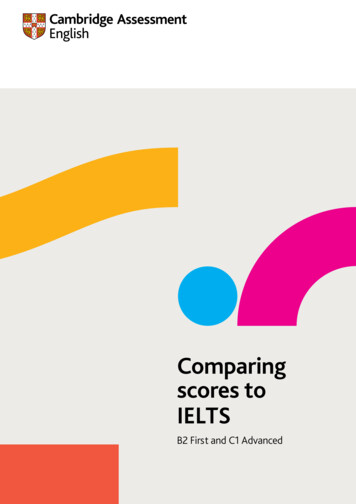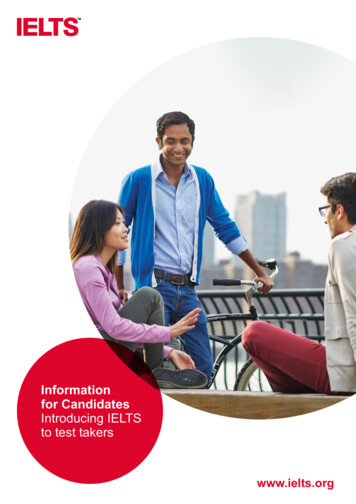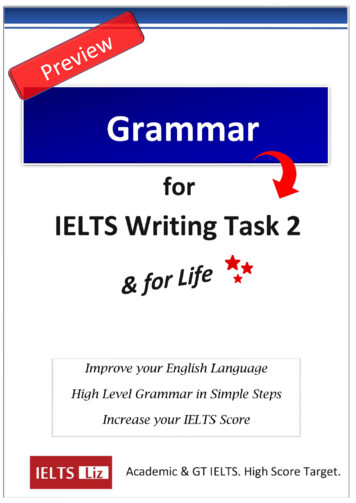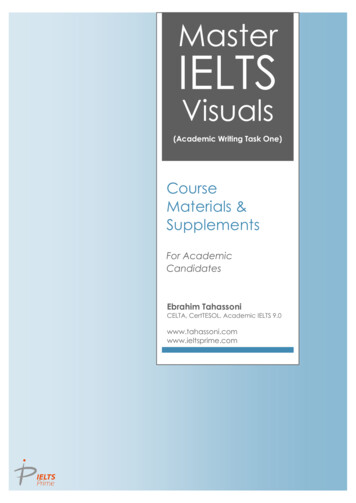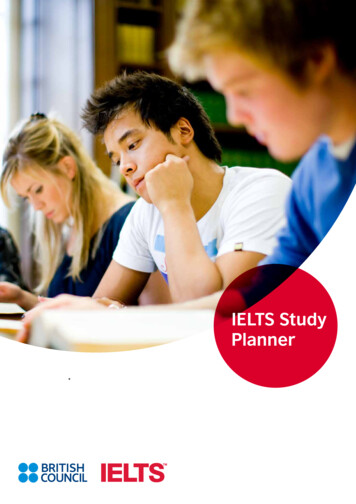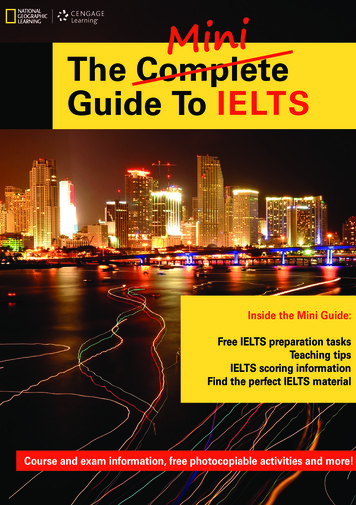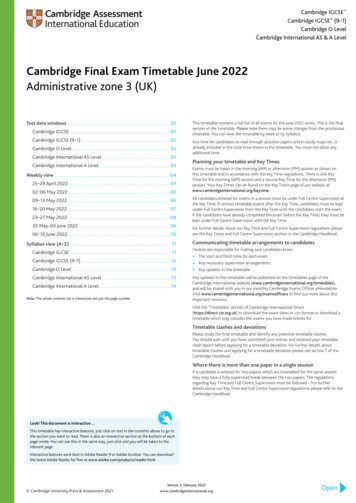
Transcription
Cambridge IELTS 6Examination papers fromUniversity of CambridgeESOL Examinations:English for Speakersof Other Languages CAMBRIDGE UNIVERSI TY P RESS
CAMBR I DGE UNIVERS ITY PRESSCambridge. New York. Melbourne, Madrid, Cape Town, Singapore, Sao PauloCambridge University PressThe Edinburgh Building, Cambridge CB2 8RU. UKwww.cambridge.orgInformation o n this title: www.cambridge.org/9780521693073 Cambridge University Press 2007It is normally necessary for written permission for copying to be obta ined inadvance from a publisher. The cand idate a nswer sheets at the back of thisbook a re designed to be copied and distributed in class. The no rmalrequirements are waived here and it is not necessary to write toCambridge University Press for permission for an individual teacher to makecopies tor usc within ltis or her own classroom. Only those pages which carrythe wording ' UCLES 2007 Photocop1.t ble ' may be copied.First published 2007] rinted in the United Kingdom at the University Press, CambridgeA catalogue record for this publication is m ailab/efrom the British LibmryISBNISBNISBNISBN978·0·521·693073 Sl1tdent's Book with answers978-0-521·693097 Cassette Set978-0-52 1-693103 Audio CD Set978-0-521-693080 Self-study f ack
ContentsIntroductionTest I10Test 233Test 355Test 4784General Training: Reading and Writing Test AI0 IGeneral Training: Reading a nd Writing Test B114Tapescripts127Answer key151Model a nd sample a nswers for Writing tasksSample answer sheetsAcknowledgements173176161
Test 1LISTE:\1!\GSECTIO N 1Questions 1- 10Questions 1-4Complete the notes below.Write NO MORE THAN THREE WORDS for each answe1:Notes on sports clubExampleAnswerName of club:JC.f!' \·!.':e! Facilities available:Golf1 . .2 . .Classes available: Kick-boxing 3 . .Additional facility:104. . . (restaurant openingsoon)
ListeningQuestio11s 5-8Complete rile table below.Wrire NO MORE THAN TWO NUMBERS (or each mswel:MEMBERSHIP SCHEMESTypeUse offacilitiesCost ofclassesTimesGOLDAllFreeAny timeSILVERAllBRONZERestricted6 . from 7 . to . 3f.-om 10.30 to 3.30weekdays onlyJ oiningfeeAnnualsubscriptionfee 2505 . 225 300 508 .Questio11s 9 alld 10Complete tile sentences below.Write ONE WORD ONLY for each cmsn·e1:9To join the centre, you need to book an instructor's . . . .10To book a tria l session, speak to David . (0458 95311 ).II
Test/SECTIO N 2Questions 11- 20Questions 11- 16What cha nge has been made to each part of the theatre?Choose S IX cmsll'ersfrom the box and ll'ri!e the correctletfel; A- G, nexf 10 ques!ions 11- 16.RIVENDEN CITY THEA TREA doubled in numberB given separate entrancecreduced in numberD increased in sizeE replacedF strengthenedG temporarily closedPart of the theatre11box office12shop13ordinary seats14seats for wheelchair users15lifts16 dressing roomst2
ListeningQuestio11s 17- 20Complete the table below.Write NO MORE THAN TWO WORDS AND/OR A NUMBER .for each lii1S1re1:PlayDatesRoyal HuntOctober 13th toof t!te Sun17 .Starting time18 . pmTickets availablePricefor 19 . .and .20 ··················13
Test ISECTION 3Questio11s 21- 30Questio11 21Choose the correct lelfe1; A, B or C21What is Brian going to do before the course starts?Aattend a classBwrite a reportCread a bookQuestio11s 22- 25Complete the table below.Write N O MORE THA N TWO WORDS for each ansll'el:College FacilityRefectoryInformationinform them 22 . . . . about special dietaryrequire ments23 .long waiting list, apply nowCareers advicedrop-in centre for informationFitness centrereduced 24 . for studentsLibraryincludes books, journals, eq uipmen t room containingaudio-visual materialsComputersask your 25 . to arrange a password withthe technical support team14
ListeningQuestio11s 26- 30Complete the summmy below.Write NO MORE THAN TWO WORDS.for each answer.Business CentreThe Business Resource Centre contains materials such as books and manuals tobe used for training. It is possible to hire 26 . and 27 . . .There are mat erials for working on study ski lls (e.g. 2S .) and othersubjects include flnance and 29 . .30 . membership costs 50 per year.15
Test ISECTION 4Questio11s 31- 40Questio11s 31- 37Complete the table be/ott:Write N O MOR E THAN T WO WORDS for each ans1re1:S ocial history of the East End of LondonP eriodSituationIst- 4th centuriesProduce from the area was used to 31. . . . thepeople of London.5th- 10th centuriesNew technology allowed the production of good s made of32 . and . . . .II th centuryLack of 33 . . . in the East End encouragedthe growth o f businesses.16th centuryConstruction of facilities for the building o f34 . stimulated international trade.Agricultural workers came from other parts o f35 . . . to look for work.17th centu ryMarshes were drained to provide land that could be36 . on.19th centuryInhabitants lived in conditions of great 37 . . .with very poor sanitation.16
ReadingQuestions 38-40Choose THREE leuers, A-GWhich THREE of the following problems are mentioned in connection with 20th centuryhousing in the East End?Aunsympathetic landlordsBunclean watercheating problemsDhigh rentsEovercrowdingFpoor standards of buildingGhouses catching fire17
Test/READII\GREADING PASS AGE 1You should spend about 20 minutes on Questions 1- 13, which are based on Reading Passage Ibelow.AUSTRALIA'SSPORTINGSUCCESSA They play hard. they play often, and they play to win. Australian sports teams win more thantheir fair share of titles, demolishing rivals with seeming ease. How do they do it?A big part ofthe secret is an extensive and expensive network of sporting academies under pinned byscience and medicine. At the Australian Institute of Sport (AIS), hundreds of youngsters andpros live and train under the eyes of coaches. Another body, the Australian Sports Commission(ASC), finances programmes of excellence in a total of 96 spor ts for thousands of sportsmenand women. Both provide intensive coaching. training facilities and nutritional advice.B Inside the academies, science takes centre stage. The AIS employs more than I 00 sportsscientists and doctors, and collaborates with scores oi others in universities and researchcentres. AIS scientists work across a number of sports. applying skills learned in one - such asbuilding muscle strength in golfers - to others. such as swimming and squash. They are backedup by technicians who design instruments to collect cata from athletes.They all focus on oneaim: winning. 'We can't waste our time looking at ethereal scientific questions that don't helpthe coach work with an athlete and improve performance; says Peter Fricker. chief ofscience at AIS.C A lot of their work comes down to measurement - everything from the exact angle of aswimmer's dive to the second-by-second power output of a cyclist. This data is used to wringimprovements out of athletes. The focus is on individLals, tweaking perfor mances to squeeze anextra hundredth of a second here, an extra millimetre there. No gain is too slight to botherwith. It's the tint. gradual improvements that add up to world-beating results.To demonstratehow the system works, Bruce Mason at AIS shows off the prototype of a 30 analysis tool ferstudying swimmers. A wire-frame model of a champion swimmer slices through the water, heranms moving in slow motion. Looking side-on, Mason measures the distance between strokes.From above, he analyses how her spine swivels. When fully developed, this system will enablehim to build a biomechanical profile for coaches to use to help budding swimmers. Mason'scontribution to sport also includes the development of the SWAN (SWimming AN alysis)system now used in Australian national competitions. It collects images from digital cameras18
Readingrunning at 50 frames a second and breaks down each part of a swimmer's performance intofactors that can be analysed individually - stroke length, stroke frequency. average duration ofeach stroke, velocity. start lap and finish times, and so on. At the end of each race, SWAN spitsout data on each swimmer.D 'Take a look,' says Mason, pulling out a sheet of data. He points out the data on the swimmers insecond and third place. which shows that the one who finished third actually swam faster. Sowhy did he finish 35 hundredths of a second down? 'His turn times were 44 hundredths of asecond behind the other guy,' says Mason.'If he can improve on his turns, he can do muchbetter.' This is the kind of accuracy that AI scientists' research is bringing to a range of sports.With the Cooperative Research Centre for Micro Technology in Melbourne, they aredeveloping unobtrusive sensors that will be embedded in an athlete's clothes or running shoesto monitor heart rate, sweating, heat production or any other factor that might have an impacton an athlete's ability to r un. There's more to it than simply measuring performance. Fricker givest he example of athletes who may be down with coughs and colds I I or 12 t imes a year: Afteryears of experimentation, AI and the University of Newcastle in New South Wales developeda test that measures how much of the immune-system prot ein immunoglobulin A is present inathletes' saliva. If lgA levels suddenly fall below a cer tain level, training is eased or droppedaltogether. Soon, lgA levels start r ising again, and the danger passes. Since the tests wereintroduced,A I athletes in all sports have been remarkably successful at staying healthy.EUsing data is a complex business. Well before a champ·ionship, sports scientists and coachesstart to prepare the athlete by developing a 'competition model', based on what they expectwill be the winning times. 'You design the model to make that time.' says Mason. 'A start of thismuch, each free-swimming period has to be this fast. with a certain stroke frequency and strokelength, with turns done in these times.' All the training is then geared towards making the athletehit those targets, both overall and for each segment of the race.Techniques like these havetransformed Australia into arguably the world's most successful sporting nation.F Of course. there's nothing to stop other countries copying - and many have tried. Some yearsago, the A IS unveiled coolant-lined jackets for endurance athletes.At the Atlanta OlympicGames in 1996, these sliced as much as two per cent off cyclists' and rowers' times. Noweveryone uses themT he same has happened to the 'attitude tent', developed by A I to replicatethe effect of altitude training at sea level. But Australia's success story is about more than easilycopied technological fixes, and up to now no nation has replicated its all-encompassing system.l9
Test 1Questions 1-7Reading Passage I has six paragraphs, A- F.Which paragraph contains the following information?Write the correct letter. A-F. in boxes 1- 7 on your answer sheet.You may use any letter m ore than once.NB1a reference to the exchange of expertise between different sports2an explanation of how visual imaging is employed in investigations3a reason for narrowing the scope of research activity4how some AIS ideas have been reproduced5how obs tacles to optimum achievement can be investigated6an overview of the funded support of athletes7how perfonnance requirements are calculated before an eventQuestions 8-11Classify the following techniques according to whether the writer states theyAare currently exclusively used by AustraliansBwill be used in the future by Australians.Care currently used by both Australians and their rivalsWrite the correct letter. A. B or C, in boxes 8-11 on your answer sheet.8cameras9sensors10protein tests11altitude tents20
ReadingQuestions 12 t nd 13Answer the questions below.Choose NO MORE THAN THREE WORDS AND/OR A NUMBER/rom the passage foreach answer.Write your answers in boxes 12 and 13 on your answer sheet.12What is produced to help an athlete plan their performance in an event?13By how much did some cyclists' performance improve at the 1996 Olympic Games?21
Test IREA DING PASSAGE 2You slrould spend about 20 minutes 011 Questions 14-26. wlriclr are hosed 011 R.eadi11g Passage 2beiOIV. f5DaOW@ 0(KJ@)?GO@ @@ Tlrt vast expansion in international trade owes much to a revolution in the businessof moving freightA International trade is growing at a startling pace. White the global economy has been expandingat a bit over 3% a year, the volume of trade has been rising at a compound annual rate of abouttwice that. Foreign products. from meat to machinery. play a more important rote in almost everyeconomy in the world, and foreign markets now tempt businesses that never much worriedabout sales beyond their nation's borders.8 What ties behind this explosion in international commerce? The general worldwide decline intrade barriers. such as customs duties and import quotas. is surely one explanation. Theeconomic opening of countries that have trad1t1onally been minor players is another. But oneforce behind the import-export boom has passed all but unnoticed: the rapidly falling cost ofgetting goods to market. Theoretically. in the world of trade. shipp1ng costs do not matter.Goods, once they have been made. are assumed to move instantly and at no cost fromplace to place. The real world, however. is full of frictions. Cheap labour may make Chineseclothing competitive in America, but if delays In shipment tie up working capital and causewinter coats to arrive in spring, trade may lose its advantages.C At the turn of the 20th century, agriculture and manufacturing were the two most importantsectors almost everywhere. accounting for about 70% of total output in Germany, Italy andFrance. and 40-50% in America, Britain and Japan. International commerce was thereforedominated by raw materials. such as wheat. WOOd and iron ore, or processed commodities,such as meat and steel. But these sorts of products are heavy and bulky a the cost oftransporting them relatively high.D Countries stilltrade'aiSpr tely with their geographic neighbours. Over time, however.world output has shifted into goodswric)'§'e·wor unrelated to their size and weight. Today.it Is finished manufactured products that dominate the 'fiQV}·ottrade;-and .-tl:la,nks.totechnological advances such as lightweight components, manufactured goods themselveshave tended to become lighter and less bulky. As a result, less transportation Is required forevery dollar's worth of imports or exports.22
ReadingE To see how this influences trade. consider the business of making disk drives for computers.Most of the world's disk-drive manufacturing is concentrated in South-east Asia. This ispossible only because disk drives. while valuable, are small and light and so cost little toship. Computer manufacturers in Japan or Texas will not face hugely bigger freight bills ifthey import drives from Singapore rather than purchasing them on the domestic market.Distance therefore poses no obstacle to the globalisation of the disk-drive industry.FThis is even more true of the fast-growing information industries. Films and compact discscost little to transport , even by aeroplane. Computer software can be 'exported' without everloading it onto a ship·, simply by transmitting it over telephone lines from one country toanother. so freight rates and cargo-handling schedules become insignificant factors indeciding where to make the product. Businesses can locate based on other considerations.such as the availability of labour, while worrying less about the cost of delivering their output.G In many countries deregulation has helped to drive the process along. But, behind thescenes, a series of technological innovations known broadly as containerisation and intermodal transportation has led to swift productivity improvements in cargo-handling. Fortyyears ago, the process of exporting or importing involved a great many stages of handling,which risked portions of the shipment being damaged or stolen along the way. The inventionof the container crane made it possible to load and unload containers without capsizing theship and the adoption of standard container sizes allowed almost any box to be transportedon any ship. By 1967, dual-purpose ships, carrying loose cargo in the hold" and containerson the deck, were giving way to all-container vessels that moved thousands of boxes at atime.H The shipping container transformed ocean shipping into a highly efficient, intenselycompetitive business. But getting the cargo to and from the dock was a different story.National governments, by and large, kept a much firmer hand on truck and railroad tariffsthan on charges for ocean freight. This started changing, however, in the mid-1970s, whenAmerica began to deregulate its transportation industry. First airlines. then road hauliers andrailways, were freed from restrictions on what they could carry, where they could haul it andwhat price they could charge. Big productivity gains resulted. Between 1985 and 1996. forexample, America's freight railways dramatically reduced their employment. trackage, andtheir fleets of locomotives - while increasing the amount of cargo they hauled. Europe'srailways have also shown marked. albeit smaller, productivity improvements.IIn America the period of huge productivity gains in transportation may be almost over. but inmost countries the process still has far to go. State ownership of railways and airlines,regulation of freight rates and toleration of anti-competitive practices. such ascargo-handling monopolies. all keep the cost of shipping unnecessarily high and deterinternational trade. Bringing these barriers down would help the world's economies grow------ · - -- ··even closer. ---·- hold: ship's storage area below deck23
Test 1Questions 14-17·'Reading Passage 2 has nine paragraphs. A- 1.Which paragraph contains the following information?Write the correctleuer. A-1, in boxes 14-17 on your answer sheet.14a suggestion for improving trade in the future15the effects of the introduction of elc:t:tronic delivery16the similar cost involved in transporting a product from abroad or from a local supplier17the weakening relationship between the value of goods and the cost of their deliveryQuestions 18-11Do the following statements agree with the information given in Reading Passage 2?In boxes 18-22 on your answer sheet, writeTRUEFALSENOTGIJIENif the statement agrees with the informationif the sta!emenl contradicts the informationif there is no information on this18International trade is increasing at a greater rate than the world economy.19Cheap labour guarantees effective trade conditions.20Japan imports more meat and steel than France.21Most countries continue to prefer to trade with nearby nations.22Small computer components are manufactured in Germany. .24- ---.-, ,. . . ., -· . . - ., .
ReadingQuestions 23-26Complete the summary using the list of words.----. . .- , ,;.- t1. K,. belmv.----- .- -· -Write the correct feller. A-K. in boxes 23-26 on your answer sheet.THE TRANSPORT REVOLUTIONModern cargo-handling methods have had a significant effect on 23 . as thebusiness of moving freight around the world becomes increasingly streamlined.Manufacturers of computers. for instance. are able to import 24 .: . .from over eas, rather than having to rely on a local supplier. The introduction of25 . has meant that bulk cargo can be safely and efficiently moved over longdistances. While international shipping is now efficient. there is still a need for governments toreduce 26 ., in order to free up the domestic cargo sector.A tariffsD outputG trade. J l standardsccontainer shipsF insurance costsI fares - -- ·--· -. --. .,. . . , - -- -----25
Test J"·'-- · READING PASSAGE 3 ,. .:---. ,- -- ·. --···· -, . ' IYou should spend about 20 minutes on Questions 27-40, which are based on Reading Passage 3on thefollowingpages. Questio-ns 27-32 Reading Passage 3 has seven paragraphs, A--G.Ch, oose the correct-heading for paragraphs B-G from the list of.headirtgs below.Write the correct number. i-ix, in boxes 27- 32. on your ans'wer sheet.·. 'List of HeadingsThe reaction of the Inuit community to climate changeUnderstanding of climate chan·ge remains limitedAlternative sources of essential suppliesRespect for Jnuit opinion growsA healthier'choice of foodvi A difficult landscapevii Negative effects on well-being.viii Alarm caused by unprecedented events in the Arcticix The benefits of an easier ll XistenceiilillivvExampleParagraph A27ParagraphB28ParagraphC29Paragraph D30Paragraph E31ParagraphF32Paragraph G26Answerviii··-. .'"·- ·--· .-:- - :-· ·
Readin .Climate Change andthe InuitThe threat po5ed by climate change in theArctic and the problem5 faced by Canada' Inuit ·················A Unusual incidents .are being reported across the Arctic. Inuit families going off onsnowmobiles to prepare their summer hunting camps have found themselves cut offfrom home by a sea of mud, following early thaws. There are reports of igloos losingtheir insulating properties as the snow drips and refreezes, of lakes draining into thesea as permafrost melts, and sea ice breaking up earl ier than usual. carrying sealsbeyond the reach of hunters. Climate change may still be a rather abstract ideato most of us, but in the Arctic it is already having dramatic effects- if summertime icecontinues to shrink at its present rate, the Arctic Ocean could soon become virtuallyice-free in summer. The knock-on effects are likely to include more warming, cloudierskies, increased precipitation and higher sea levels. Scientists are i ncreasinglykeen to find out what's going on because they consider the Arctic the 'canary in themine' for global warming - a warning of what's in store for the rest of the World.B For the Inuit the problem is urgent. They live in precarious balance with one of thetoughest environments on earth. Climate change, whatever its causes, is a direct threatto their way of life. Nobody knows the Arctic as well as the locals, which is why they arenot content simply to stand back and let outside experts tell them what's happening. InCanada, where the Inuit people are jealously guarding thei r hard-won autonomy in thecountry's newest territory, Nunavut, they believe their best hope of survival in thischanging environment lies in combini ng their ancestral knowledge with the best ofmodern science. This is a challenge in itself.C The Canadian Arctic is a vast, treeless polar desert that's covered with snow for most ofthe year. Venture into this terrain and you get some idea of the hardships facing anyonewho calls this home. Farming is out of the question and nature offers meagre pickings.Humans f irst settled in the Arctic a mere 4,500 years ago, surviving by exploiting seamammals and fish. The environment tested them to the limits: sometimes the colonistswere successful,' sometimes they failed and vanished. But around a thousand years ago,one group emerged that w as uniquely well adapted to cope with the Arcticenvironment. These Thule people moved in from Alaska, bringing kayaks, sleds, dogs,pottery and iron tools. They are the ancestors of today's Inuit people . D- ! f?r th cen an,ts of thV '- : t "Opfe''is Srt'lli'iafsn."Nu·n avufis' 1'.9 million squareRtmmetres of rock an d a handful of islands around the North Pole. It's currentlyhome to 2,500 people, all but a handful of them indigenous Inuit. Over the past 40years, most have abandoned the ir nomadic ways and settled in the territory's 28 isolatedcommun ities, but they still rely heavily on nature to provide food and clothing.27
ListeningTest2LISTENINGSECTION IQuestions 1-1 IJQuestions 1-5Complete the notes below.Write NO MORE THAN TWO WORDS AND/OR A NUMBER for each answer.CHILDREN'S ART AND CRAFT WORKSHOPSExampleWorkshops organised every:AnswerSaturday Adults must accompany children under 1 . . Cost 2.50 Workshops held in: Winter House, 2 . Street Security device: must push the 3 . to open door Should leave car behind the 4 . . Book workshops by phoning the 5 . (on 200765)
Test2Questions 6-10Complete the table below.Write NO MORE THAN TWO WORDS for each answer.Next two workshops16/11'Building6 . '7 . .8 . .23/119' . '(Nothing special)10 . .34Evisa* J. Et\H-fft QQ:l5970184
ListeningSECTION 2Questions 11-20Questions 11-14Complete the sentences below.Write NO MORE THAN TWO WORDS AND/OR A NUMBERjor each answer.TRAIN INFORMATION11Local services depart from . railway station.12National services depart from the . railway station.13Trains for London depart every . each day during the week.14The price of a first class ticket includes . .Questions 15-17Complete the table below.Write NO MORE THAN TWO WORDS ANDIOR A NUMBER for each answer.Standard openno restrictionsSupersavetravel after 8.45Specialtravel after 15 . and at weekends16 . .buy at least six days aheadlimited numbers17 . essential35Evisa** JII:t!Hifr QQ: 15970184
Test2Questions 18-20Choose THREE letters, A -G.Which THREE attractions can you visit a, present by train from Trebirch?A a science museumBa theme parkca climbing wallD a rmnmg museumEan aquanumFa castleGa zoo
ListeningSECTION3Questions 21-30Complete the tables below.Write NO MORE THAN THREE WORDS AND/OR A NUMBER for each answer.Dissertation Tutorial Record (Education)Name: Sandy GibbonsTargets previously agreedWork completedFurther action suggestedRead IT 21 .-Spoken to Jane Prince,Head of the 22 .- Completed and sent forreviewSign up for somesoftware practiceFurther reading about-Read BanerjeeObtain from librarydiscipline- N.B. Couldn't findEricsson'sthrough special loansInvestigate suitable dataanalysis softwarePrepare a 23 .for surveysessionsAdd questions in sectionthree on 24 .serviceessays on managing the25 . . . . . . . . .New TargetsDo further work onChapter 1(Give the title:Context26.)Prepare list of mainsections for Chapter 2Speeific suggestions- Add statistics on the27 . 'in variouszones- Include morereferences toworks dated after28 .Use index cards tohelp in organisationTimingBy the 29 .Before starting the30 .37
Test2SECTION 4Questions31-40Questions 31-37Choose the correct letter, A, B or C.The history of moving pictures31Some photographs of a horse running showedABC32all feel off the grmmd.at least one foot on the grmmd.two feet off the gronnd.The Scotsman employed by EdisonABC3334designed a system to use the teclmology Edison had invented.used available teclmology to make a new system.was already an expert in motion picture teclmology.One major problem with the first system was thatABonly one person could be filmed.people could only see very short films.Cthe camera was very heavy.Rival systems started to appear in Europe after people hadABCsystem.35In 1895. a famous new system was developed byA3637been told about the American systemseen the American system.used the Americana French team working alone.Ba French and German team working together.Ca German team who invented the word 'cinema'.Longer films were not made at the time bacause of problems involvingAthe subject matter.Bthe camera.Cthe film projector.The 'Lantham Loop 1 invention relied onABCremoving tension between the fihn reels.adding three more film reels to the system.making one of the fihn reels more effective.
ListeningQuestions 38-40Complete the sentences below.Write NO MORE TIIAN THREE WORJ)S for each answer.38The first motion picture was called The . .39. were used for the first time on fihn in 1926.40Subtitles were added to The Lights of New York because of its39
Test2READINGREADING PASSAGE 1You should spend about 20 minutes on Questions 1-13, which are based on ReadinzPassage 1on the followillg pages.Questions 1-5Reading Passage 1 has five marked paragraphs. A-E.Choose the correct heading for each paragraph from the list of headings below.Write the correct number,i-viii, in boxes 1-5 on your answer sheetList of headingsAvoiding an overcrowded centreiiAsuccessful exercise in people poweriiiThe benefits of working together in citiesivHigher incomes need not mean more carsvEconomic arguments fail to persuadeviThe impact of telecommuications on population distributionviiiResponding to arguments against public transport1Paragraph A2Paragraph B3Paragraph C4Paragraph D5Paragraph E40 pag
Cambridge IELTS 6 Examination papers from University of Cambridge ESOL Examinations: English for Speakers of Other Languages CAMBRIDGE UNIVERSITY PRESS . CAMBRIDGE UNIVERSITY PRESS Cambridge. New York. Melbourne, Madrid, Cape Town, Singapore, Sao Paulo Cambridge University Press


